Complete FIDE Regulations for Chess960 Tournament Play
Hello chess friends, are you familiar with the chess960 rules? Here are the FIDE regulations that govern chess960 play in tournaments. We are sure you would find them useful.
From the FIDE Handbook
Appendix F. Chess960 Rules
F.1 Before a Chess960 game a starting position is randomly set up, subject to certain rules.
After this, the game is played in the same way as standard chess. In particular, pieces and pawns have their normal moves, and each player's objective is to checkmate the opponent's king.
F.2 Starting-position requirements
The starting position for Chess960 must meet certain rules. White pawns are placed on the second rank as in regular chess. All remaining white pieces are placed randomly on the first rank, but with the following restrictions:
a. the king is placed somewhere between the two rooks, and
b. the bishops are placed on opposite-coloured squares, and
c. the black pieces are placed opposite the white pieces.
The starting position can be generated before the game either by a computer program or using dice, coin, cards, etc.
F.3 Chess960 castling rules
a. Chess960 allows each player to castle once per game, a move by potentially both the king and rook in a single move. However, a few interpretations of standard chess rules are needed for castling, because the standard rules presume initial locations of the rook and king that are often not applicable in Chess960.
b. How to castle
In Chess960, depending on the pre-castling position of the castling king and rook, the castling manoeuvre is performed by one of these four methods:
From Alexandra Kosteniuk's
From the FIDE Handbook
Appendix F. Chess960 Rules
F.1 Before a Chess960 game a starting position is randomly set up, subject to certain rules.
After this, the game is played in the same way as standard chess. In particular, pieces and pawns have their normal moves, and each player's objective is to checkmate the opponent's king.
F.2 Starting-position requirements
The starting position for Chess960 must meet certain rules. White pawns are placed on the second rank as in regular chess. All remaining white pieces are placed randomly on the first rank, but with the following restrictions:
a. the king is placed somewhere between the two rooks, and
b. the bishops are placed on opposite-coloured squares, and
c. the black pieces are placed opposite the white pieces.
The starting position can be generated before the game either by a computer program or using dice, coin, cards, etc.
F.3 Chess960 castling rules
a. Chess960 allows each player to castle once per game, a move by potentially both the king and rook in a single move. However, a few interpretations of standard chess rules are needed for castling, because the standard rules presume initial locations of the rook and king that are often not applicable in Chess960.
b. How to castle
In Chess960, depending on the pre-castling position of the castling king and rook, the castling manoeuvre is performed by one of these four methods:
1. double-move castling: by making a move with the king and a move with the rook,
or
2. transposition castling: by transposing the position of the king and the rook, or
3. king-move-only castling: by making only a move with the king, or
4. rook-move-only castling: by making only a move with the rook.
Recommendations
1. When castling on a physical board with a human player, it is recommended that the king be moved outside the playing surface next to his final position, the rook then be moved from its starting position to its final position, and then the king be placed on his final square.
2. After castling, the rook and king's final positions should be exactly the same positions as they would be in standard chess.
Clarification
Thus, after c-side castling (notated as 0-0-0 and known as queen-side castling in orthodox chess), the king is on the c-square (c1 for white and c8 for black) and the rook is on the d-square (d1 for white and d8 for black). After g-side castling (notated as 0-0 and known as king-side castling in orthodox chess), the king is on the g-square (g1 for white and g8 for black) and the rook is on the f-square (f1 for white and f8 for black).
Notes
1. To avoid any misunderstanding, it may be useful to state "I am about to castle" before castling.
2. In some starting positions, the king or rook (but not both) does not move during castling.
243. In some starting positions, castling can take place as early as the first move.
4. All the squares between the king's initial and final squares (including the final square) and all the squares between the rook's initial and final squares (including the final square) must be vacant except for the king and castling rook.
5. In some starting positions, some squares can stay filled during castling that would have to be vacant in standard chess. For example, after c-side castling 0-0-0, it is possible to have a, b, and/or e still filled, and after g-side castling (0-0), it is possible to have e and/or h filled.
Here is a nice video featuring 12th Women's World Chess Champion Alexandra Kosteniuk who is also won the Women's World Chess360 Chess title twice over.
Chess Queen™ Alexandra Kosteniuk has also held a 20-board chess960 simul! Read all about it at www.chessqueen.com.
or
2. transposition castling: by transposing the position of the king and the rook, or
3. king-move-only castling: by making only a move with the king, or
4. rook-move-only castling: by making only a move with the rook.
Recommendations
1. When castling on a physical board with a human player, it is recommended that the king be moved outside the playing surface next to his final position, the rook then be moved from its starting position to its final position, and then the king be placed on his final square.
2. After castling, the rook and king's final positions should be exactly the same positions as they would be in standard chess.
Clarification
Thus, after c-side castling (notated as 0-0-0 and known as queen-side castling in orthodox chess), the king is on the c-square (c1 for white and c8 for black) and the rook is on the d-square (d1 for white and d8 for black). After g-side castling (notated as 0-0 and known as king-side castling in orthodox chess), the king is on the g-square (g1 for white and g8 for black) and the rook is on the f-square (f1 for white and f8 for black).
Notes
1. To avoid any misunderstanding, it may be useful to state "I am about to castle" before castling.
2. In some starting positions, the king or rook (but not both) does not move during castling.
243. In some starting positions, castling can take place as early as the first move.
4. All the squares between the king's initial and final squares (including the final square) and all the squares between the rook's initial and final squares (including the final square) must be vacant except for the king and castling rook.
5. In some starting positions, some squares can stay filled during castling that would have to be vacant in standard chess. For example, after c-side castling 0-0-0, it is possible to have a, b, and/or e still filled, and after g-side castling (0-0), it is possible to have e and/or h filled.
Here is a nice video featuring 12th Women's World Chess Champion Alexandra Kosteniuk who is also won the Women's World Chess360 Chess title twice over.
Chess Queen™ Alexandra Kosteniuk has also held a 20-board chess960 simul! Read all about it at www.chessqueen.com.
From Alexandra Kosteniuk's
www.chessblog.com
Also see her personal chess blog
at www.chessqueen.com
Don't miss Chess Queen™
YouTube Channel
Also see her personal chess blog
at www.chessqueen.com
Don't miss Chess Queen™
YouTube Channel
Labels: Alexandra Kosteniuk, Chess960






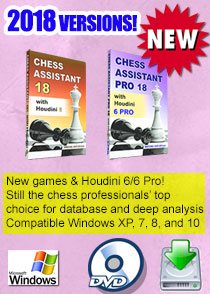























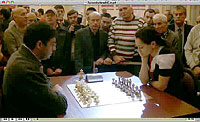
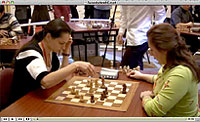
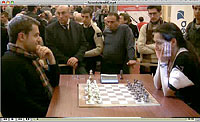

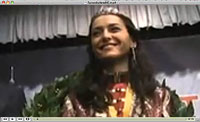

0 Comments:
Post a Comment
Note: Only a member of this blog may post a comment.
Subscribe to Post Comments [Atom]
<< Home